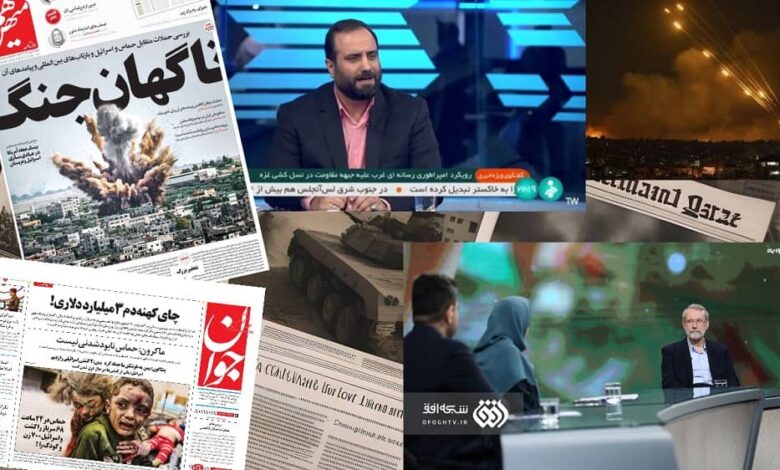Iranian Regime Shifts Focus to MEK Amidst Gaza Crisis Propaganda

iran propaganda gaza war
Written by
Mohammad Sadat Khansari
Before the beginning of the recent war in Gaza, Ali Khamenei, the Supreme Leader of the Iranian regime, faced severe crises. A wave of nationwide uprisings by various segments of the population aiming to overthrow him, intensifying internal strife, multiple socio-economic crises, and the increasing success of an organized resistance force gaining international credibility and recognition independently and consistently.
With the onset of the Gaza war, Khamenei and his inner circle believed that without addressing the country’s infrastructural complications and responding to the genuine demands of the people, they could manage to bring about miracles and still all the crises at once. However, everything quickly went contrary to Khamenei’s expectations.
Within days, public opinion worldwide accused the Iranian regime of fueling the Gaza war. Iranians, through boycotting state-sponsored rallies and engaging on social media, rejected the regime’s narrative. Simultaneously, protests against the regime intensified, demonstrating that the core issue could not be evaded. Daring nightly operations by rebellious youth targeting government centers and security forces signaled that an uprising was imminent.
The regime’s response was an escalation of repression and intimidation. The regime’s judiciary increased the pace of executions and other capital punishment and laws designed to suppress the society were put into action in the regime’s power centers, ensuring it dominated the headlines. But the ruling clerics also took other actions.
The regime’s intelligence agencies instructed a state-affiliated film production company called “Oj Institution” to produce a movie against the Mujahedin-e-Khalq Organization (PMOI/MEK) and extensively screen it in cinemas across the country. Since the movie failed to receive widespread public embracement, the regime employed another unconventional method to compel people to watch it.
By mid-November, video clips on social media showed how young girls dressed in uniforms resembling the National Liberation Army’s attire were moving between cars in Tehran. After stopping traffic on a major road, they handed out leaflets to drivers, ordering them not to watch the movie “Colonel Souraya.” While this move attracted public attention, though as the regime’s plan was obvious to Iranians, it rapidly faced social backlash.
NCRI Editorial | Deciphering Regime’s Legal Theatrics Against Iran’s Resistance
The objective is to extend suppression of the MEK members & activists to European soil and deny them their fundamental rights.#IranRevolution, #MEK, #Ashraf3, https://t.co/2TFLxkHqyK— NCRI-U.S. Rep Office (@NCRIUS) August 3, 2023
In an interview with the state-run Farhikhtegan newspaper on December 2, the movie’s director Leili Aj confessed that despite lacking cinema education, she was summoned by the government to make a movie about the MEK. She also revealed that after reading three books published by the Ministry of Intelligence (MOIS), to gain insight into the organization, she went ahead to interview several quitters who had turned against the MEK.
An interesting point in this interview was her admission of how, after the movie’s production and screening, many of her peers and coworkers boycotted her. Some even contacted her, stating that they would no longer communicate with her, and informed her that they had unfollowed her on social media. She sarcastically remarked, “I didn’t know that the MEK had so many secret sympathizers.”
Meanwhile, after months of spreading propaganda, the clerical dictatorship recently declared its intention to conduct a new trial for 104 members and officials of the MEK (Mujahedin-e Khalq) and the National Council of Resistance of Iran. It’s worth noting that this regime has executed or assassinated over 120,000 MEK members and supporters, as well as individuals associated with the NCRI. Given this track record, the upcoming legal proceedings are unlikely to deliver anything resembling justice.
Over the past 44 years, the clerical dictatorship has invested significant resources, amounting to billions of dollars, in disseminating its message. This includes the publication of thousands of books and pamphlets, the creation of numerous websites, the production of hundreds of movies and documentaries, the development of TV series, and the organization of countless conferences and book fairs. Additionally, the regime employs numerous undercover agents posing as journalists, experts, academics, and “Iran experts,” both within and outside Iran, intending to tarnish the public image of the Iranian Resistance.
As the past is prologue, the regime’s desperate attempts to shift focus away from its fundamental issues and fabricate external crises suggest that additional efforts to tarnish the reputation of the MEK are destined to fail. Instead, a society eager to break free from tyranny will increasingly learn about those most feared by Khamenei’s regime.

